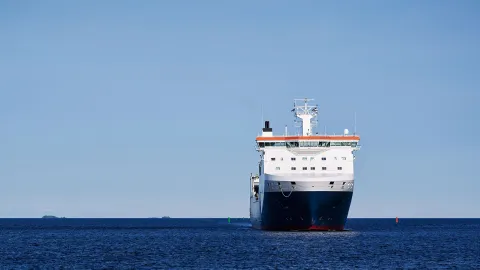Poseidon Principles: The CO2 emissions of Finnvera's ship financing portfolio decreased – The new climate trajectory sets a more ambitious target to cut emissions
The world's largest cruise ship, Icon of the Seas, representing the technological peak of its class, is the latest ship to depart from the Meyer Turku shipyard in Finland. Photo: Meyer Turku/Mediascope Productions.
Published date
The CO2 emissions of Finnvera's ship financing portfolio developed as desired and clearly decreased from the previous year in the calculation based on the original target of the international Poseidon Principles iniative. The original target is consistent with the policies and ambitions of the International Maritime Organization (IMO), including its ambition to reduce shipping’s total annual greenhouse gas emissions by at least 50% of 2008 levels by 2050. However, according to the new goal set by Poseidon Principles aligned with IMO’s revised greenhouse gas strategy, which aims for net-zero emissions by 2050, Finnvera does not yet meet the goal. Finnvera calculated the emissions of the ship finance portfolio for the third time.
The cruise shipping industry, which is significant in Finnvera's export credit guarantee exposure, has recovered from the exceptional years, and ships are operating normally again. This was reflected in our score aligned with the original IMO 50% target, -13.2%, which was well below the target, and which also explains the volatility compared to 2022 when Finnvera’s score was +57.3%.
“Measured by this trajectory, we are on a good path. However, in relation to the new IMO ambition, we do not yet reach the trajectory. The new ambition takes more widely into account the full life cycle of the fuel-related emissions, such as methane emissions. The impact of the change in calculation method is most evident in regard to LNG. This has a concrete effect on Finnvera’s score since approximately two-thirds of our ship finance portfolio covered by the Poseidon Principles are LNG-powered vessels”, says Nina Karisalo, Sustainability Manager at Finnvera.
The Poseidon Principles members are leading ship financiers, such as international banks, but there are export credit agencies among them.Finnvera became signatory to the Poseidon Principles in April 2021. The initiative aimed at decarbonization of shipping is a concrete measure of sustainability in the emission calculation of Finnvera's operations.
“Poseidon Principles have brought measurability and comparability to the monitoring of the climate impacts of Finnvera's ship finance. The climate alignment score gives us valuable information about the climate effects of our financing and that of the shipping industry, that covers a considerable share of our exposure. It also supports assessing the effects of Finnvera's own operations. The calculation has improved the quality of the data as a source for assessment, based to which we are also able to specify our reporting on climate impacts”, says Karisalo.
The ambition in CO2 calculation grows – In the long run the transition will lead to solutions with fewer emissions
The shipyard cluster is significant in Finland, and approximately half of Finnvera's EUR 23.6 billion export credit guarantee exposure is related to ship cluster. The share of drawn ship exposure is EUR 6.5 billion (Q3/2023).
“Mitigating climate change is a key strategic issue for Finnvera. In recent years, we have been actively developing measures in line with the trajectory. However, the ambition of measuring emissions has risen faster than the technological development. In the long run we believe that the transition in the shipping industry will lead to solutions with fewer emissions. A good example of a future development is the NEcOLEAP project of the Meyer Turku shipyard in Finland, where the aim is to develop a climate-neutral cruise ship concept by 2025. The project is financed by Business Finland, which is part of the Team Finland network along with Finnvera. As an export credit agency, Finnvera also has good opportunities to influence the development of climate solutions, as we essentially finance new projects and new technology aiming to build more environmentally efficient ships than the current ones”, says Jussi Haarasilta Executive Vice President.
This is how the CO2 level is calculated according to Poseidon Principles
Poseidon Principles measures carbon intensity. The data based on which the overall climate alignment score is calculated is distance travelled, amount of fuel consumption for each fuel type, and size of the vessel. The outstanding debt per vessel also play a role when calculating the weighted average of the scores. The calculation is based on a formula that takes into account the distance traveled by the vessels during the year.
The calculation is based on the previous year’s data, and thus, the CO2 level being reported now has been calculated based on the year 2022.
Further information:
Nina Karisalo, Sustainability Manager, Finnvera, tel. +358 29 460 2964
Jussi Haarasilta, Executive Vice President, Large Corporates, Finnvera, tel. +358 29 460 2601
Poseidon Principles report (PDF)
The Poseidon Principles 2023 Annual Disclosure Report sets a new standard for climate reporting
Poseidon Principles
The Copenhagen-based Poseidon Principles, launched in June 2019, are developed by leading international shipping banks, international industry players and academic institutions as well as export credit agencies. 34 Signatories jointly represent approximately USD 200 billion in shipping finance. Finnvera became signatory to the Poseidon Principles in April 2021. Among the Signatories, there are also export credit agencies of other countries.
Read also:



